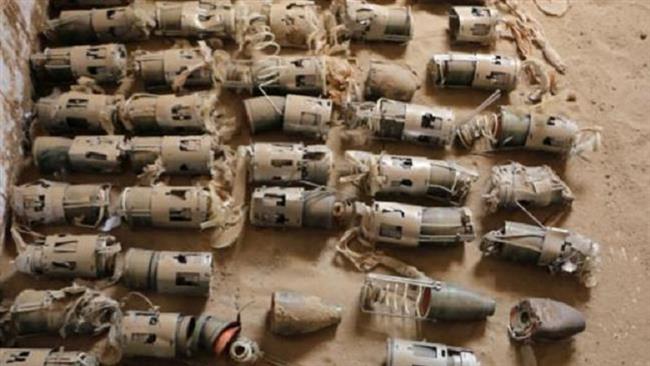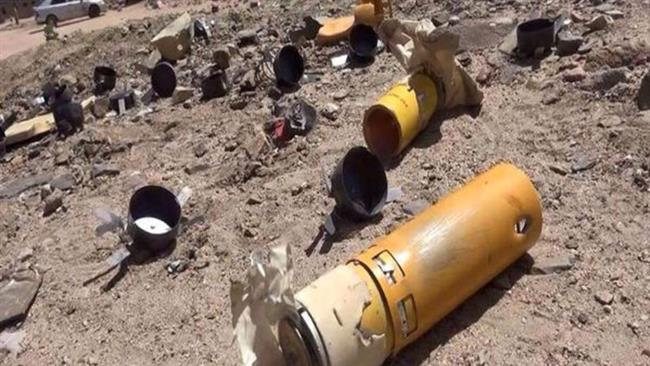Saudi jets bomb northwestern Yemen with banned munitions
Saudi warplanes have pounded Yemen’s northwestern province of Sa’ada with at least two cluster bombs despite a global outcry against the use of such internationally-banned weapons by Saudi Arabia.
According to Yemen's Arabic-language al-Masirah television network, the airstrikes were carried out against al-Malahit area in Az Zahir district on Monday afternoon, but there were no immediate reports of casualties or damage.
The Saudi war machine has already used cluster bombs across Yemen on multiple occasions despite the inherently indiscriminate nature of cluster munitions. Various rights groups, including Amnesty International and Human Rights Watch, have on many occasions reported and criticized the use of cluster bombs by Riyadh’s military in Yemen.
On March 9, the Amnesty International rights group said in a statement that Saudi Arabia had used cluster bombs on three residential districts and agricultural land in Sa’ada back in mid-February.
Last December, Human Rights Watch also said Saudi Arabia had fired cluster bombs near two schools in Sa’ada, killing two civilians and wounding six others, including a child.
Cluster bombs are banned under the Convention on Cluster Munitions (CCM), an international treaty that addresses the humanitarian consequences and unacceptable harm caused to civilians by cluster munitions through a categorical prohibition and a framework for action. The weapons can contain dozens of smaller bomblets, dispersing over vast areas, often killing and maiming civilians long after they are dropped.
Meanwhile, Yemeni snipers managed to kill at least two Saudi soldiers during a retaliatory attack on a Saudi military base in the kingdom's southern province of Najran. Since March, dozens of Saudi troops and Saudi mercenaries have been killed by Yemeni snipers in Najran and Jizan, another southwestern Saudi province.

In another development on Monday afternoon, terrorists suspected of belonging to the al-Qaeda in the Arabian Peninsula (AQAP) terror group detonated an explosive-laden car at the gates of a building, used as a temporary headquarters by militia loyal to Yemen’s resigned president Abd Rabbuh Mansur Hadi, in the city of Hawtah in Yemen’s southwestern province of Lahij.
Shortly after the deafening blast, AQAP militants, dressed as the militia, attacked the headquarters but faced fierce resistance from the guards. The explosion and the ensuing gunfire have so far killed at least eight people and wounded dozens more, mostly from the militia.
On March 26, 2015, Saudi Arabia, backed by a number of African and Persian Gulf Arab states, began launching airstrikes on different areas across Yemen, its southern neighbor, in an attempt to reinstate Hadi, who is a close Riyadh ally, and to crush the popular Houthi Ansarullah movement.
According to the United Nations humanitarian coordinator for Yemen, Jamie McGoldrick, the Saudi military campaign has claimed the lives of 10,000 Yemenis and left 40,000 others wounded.
However, in a report released on February 23, Yemen’s Legal Center for Rights and Development, an independent monitoring group, put the civilian death toll in the war-torn Arab country at 12,041. The fatalities, it said, comprise 2,568 children and 1,870 women. The rights body said the bombings have also wounded 20,001 civilians, including 2,354 children and 1,960 women, while more than four million others have been displaced.
The Saudi war has also taken a heavy toll on the country’s facilities and infrastructure, destroying many hospitals, schools and factories.
'Israel booby-trapped walkie-talkies, pagers years before Lebanon blasts'
Gaza Health Ministry calls for urgent intl. help to protect hospitals amid Israeli genocide
Stakes involved in Iran’s partnership with Eurasian Union
VIDEO | Press TV's news headlines
Iran says ‘ready’ to reopen embassy in Syria, holds talks with Damascus
VIDEO | 12 people killed in ammunition factory blast in northwest Turkey
Iraq’s PMU masses resistance forces on border with Syria amid mounting concerns
Israel killed over 700 athletes in Gaza since October 2023















 This makes it easy to access the Press TV website
This makes it easy to access the Press TV website